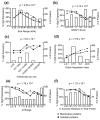Characteristics affecting expression and solubilization of yeast membrane proteins
- PMID: 17078969
- PMCID: PMC1839945
- DOI: 10.1016/j.jmb.2006.10.004
Characteristics affecting expression and solubilization of yeast membrane proteins
Abstract
Biochemical and structural analysis of membrane proteins often critically depends on the ability to overexpress and solubilize them. To identify properties of eukaryotic membrane proteins that may be predictive of successful overexpression, we analyzed expression levels of the genomic complement of over 1000 predicted membrane proteins in a recently completed Saccharomyces cerevisiae protein expression library. We detected statistically significant positive and negative correlations between high membrane protein expression and protein properties such as size, overall hydrophobicity, number of transmembrane helices, and amino acid composition of transmembrane segments. Although expression levels of membrane and soluble proteins exhibited similar negative correlations with overall hydrophobicity, high-level membrane protein expression was positively correlated with the hydrophobicity of predicted transmembrane segments. To further characterize yeast membrane proteins as potential targets for structure determination, we tested the solubility of 122 of the highest expressed yeast membrane proteins in six commonly used detergents. Almost all the proteins tested could be solubilized using a small number of detergents. Solubility in some detergents depended on protein size, number of transmembrane segments, and hydrophobicity of predicted transmembrane segments. These results suggest that bioinformatic approaches may be capable of identifying membrane proteins that are most amenable to overexpression and detergent solubilization for structural and biochemical analyses. Bioinformatic approaches could also be used in the redesign of proteins that are not intrinsically well-adapted to such studies.
Figures










References
-
- Loll PJ. Membrane protein structural biology: the high throughput challenge. J Struct Biol. 2003;142:144–53. - PubMed
-
- Wiener MC. A pedestrian guide to membrane protein crystallization. Methods. 2004;34:364–72. - PubMed
-
- Werten PJ, Remigy HW, de Groot BL, Fotiadis D, Philippsen A, Stahlberg H, Grubmuller H, Engel A. Progress in the analysis of membrane protein structure and function. FEBS Lett. 2002;529:65–72. - PubMed
-
- Canaves JM, Page R, Wilson IA, Stevens RC. Protein biophysical properties that correlate with crystallization success in Thermotoga maritima: maximum clustering strategy for structural genomics. J Mol Biol. 2004;344:977–91. - PubMed
Publication types
MeSH terms
Substances
Grants and funding
LinkOut - more resources
Full Text Sources
Molecular Biology Databases

